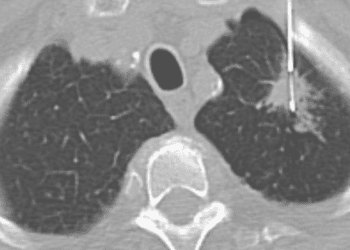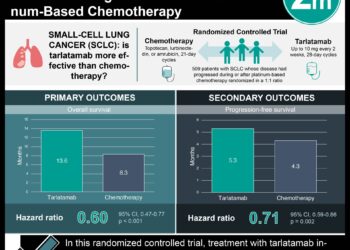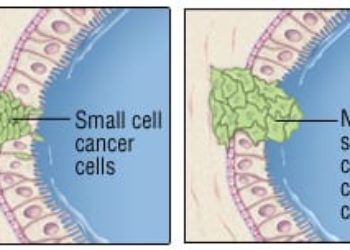Hypofractionated image-guided radiotherapy non-superior to conventional radiotherapy for patients with stage II/III non-small cell lung cancer
1. Hypofractionated image-guided radiotherapy was not superior to conventionally fractionated radiotherapy monotherapy for patients with stage II/III non-small cell lung cancer ineligible for concurrent chemoradiotherapy owing to performance status.
2. Additional investigations are needed to evaluate equivalence between hypofractionated image-guided radiotherapy vs conventionally fractionated radiotherapy and to clarify the most effective treatment regimens for patients who cannot tolerate concurrent chemoradiotherapy.
Evidence Rating Level: 1 (Excellent)
Study Rundown: Concurrent chemotherapy and conventionally fractionated radiotherapy (CFRT) followed by immunotherapy is the most effective curative option for patients with inoperable stage II/III non-small cell lung cancer (NSCLC). However, the improvements in local control achieved through chemoradiotherapy comes at the expense of increased toxic effects, outweighing potential benefits and excluding a significant number of patients vulnerable to these toxic effects from receiving standard treatment. Furthermore, the efficacy of CFRT monotherapy is greatly reduced without the effects of concurrent chemotherapy. This phase 3 randomized clinical trial sought to determine whether hypofractionated image-guided radiotherapy (IGRT) would improve overall survival in patients with stage II/III NSCLC excluded from receiving concurrent chemoradiotherapy due to toxic effects and therefore were traditionally recommended to receive CFRT monotherapy. The main endpoint of the analysis was overall survival at 1 year among patients treated with hypofractionated IGRT vs CFRT. Secondary endpoints included median overall survival, progression-free survival, local control, and toxic effects (scored according to Common Terminology Criteria for Adverse Events). Among 96 patients with NSCLC enrolled in the study, hypofractionated IGRT did not demonstrate an improvement in overall survival compared with CFRT, along with no significant difference in secondary endpoints between the 2 treatment groups. These findings suggested that hypofractionated IGRT was not superior to CFRT monotherapy for patients with stage II/III NSCLC ineligible for concurrent chemoradiotherapy owing to performance status. However, patients with node-negative disease may potentially benefit from receiving hypofractionated IGRT as favorable outcomes have been observed in phase 2 clinical trials. Additional investigations are needed to evaluate equivalence between hypofractionated IGRT vs CFRT and to clarify the most effective treatment regimens for patients who cannot tolerate concurrent chemoradiotherapy. A limitation of this study was that during a planned interim analysis, the collected data demonstrated futility in reaching the primary endpoint, resulting in the trial’s closure before reaching the enrollment goal. This consequently reduced the anticipated number of participants in the analysis, limiting statistical power and multivariate analysis.
Click to read the study in JAMA Oncology
Click to read an accompanying editorial in JAMA Oncology
In-Depth [randomized controlled trial]: This nonblinded, multicenter, phase 3 randomized clinical trial enrolled 103 patients, 96 of whom were analyzed (63 men (65.6%); mean [SD] age, 71.0 [10.2] years; median [range] follow-up, 8.7 [3.6-19.9] months) in the US from November 2012 to August 2018, with data analysis completed in April 2021. Enrollment and randomization were terminated when a planned interim analysis demonstrated futility in reaching the primary endpoint and the study was closed. Inclusion criteria included patients with stage II/III NSCLC (Zubrod performance status of at least 2), greater than 10% weight loss in the previous 6 months, and/or patients who were ineligible for concurrent chemoradiotherapy after oncology consultation. Patients were randomized to hypofractionated IGRT (n = 50; 60 Gy in 15 fractions) or CFRT (n = 46; 60 Gy in 30 fractions). For 1-year overall survival, no significant difference was observed between the hypofractionated IGRT (37.7% [95% CI, 24.2%-51.0%]) vs CFRT (44.6% [95%CI, 29.9%-58.3%]; P = .29) treatment groups. For secondary objectives, no significant differences were observed in median overall survival, progression-free survival, time to local failure, time to distant metastasis, and toxic effects of grade 3 or greater between IGRT vs CFRT groups.
Image: PD
©2021 2 Minute Medicine, Inc. All rights reserved. No works may be reproduced without expressed written consent from 2 Minute Medicine, Inc. Inquire about licensing here. No article should be construed as medical advice and is not intended as such by the authors or by 2 Minute Medicine, Inc.







